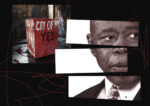The Adams administration made its pitch on the mayor’s signature housing policy to the City Council on Monday, arguing that the City of Yes for Housing Opportunity is a crucial update to New York City’s zoning.
During a hearing on Monday, some City Council members made clear that they want parking requirements maintained in transit deserts and are concerned about the effects of increased housing on parking demand and sewer capacity.
The proposal will be a test for the Adams administration, as the mayor is embroiled in a corruption scandal. A weakened administration could mean that the City Council has more leverage in securing changes to the proposal and demanding city capital as a condition of approving the text amendment.
When asked about potential changes on Monday, Department of City Planning Director Dan Garodnick said he expects revisions but hopes “the Council will keep this proposal intact.”
Council members’ line of questioning at the hearing highlighted the key concerns. Brooklyn Council member Kevin Riley, who chairs the Subcommittee on Zoning and Franchises, asked how the administration studied the effects of increasing housing construction on sewer and water infrastructure.
Garodnick said the potential increase in housing in each neighborhood is so incremental that the proposal does not need to ramp up investment in sewer or water infrastructure outside the Department of Environmental Protection’s regular process.
City of Yes is projected to add between 58,000 and 109,000 new housing units by 2039, which works out to a little less than one unit per acre over 15 years. That barely makes a dent in Mayor Eric Adams’ “moonshot” goal of adding 500,000 homes over the next decade.
“It is so little density that it does not have a significant adverse effect,” Garodnick said.
Parking woes
In the lead up to the hearing, opposition to the proposal has largely revolved around the elimination of parking minimums, legalization of accessory dwelling units and the encouragement of more development near transit. Concerns on these issues were repeatedly raised during the hearing.
Queens Council member Selvena Brooks-Powers questioned eliminating parking minimums for new construction throughout the city, rather than in just transit-rich areas. Garodnick said City Planning expects developers in transit deserts to continue to include parking in areas where demand is high.
Off-street parking can cost as much as $150,000 per space, according to Open Plans, money that developers would prefer to spend on revenue-producing housing. Brooks-Powers argued that eliminating parking requirements would put her at a disadvantage in rezoning negotiations because instead of pushing for more investments in her district, she would need to fight for parking.
Another theme of the hearing was that the text amendment is not a silver bullet.
City Council Speaker Adrienne Adams said last week that she felt the text amendment does not go far enough to address the city’s housing shortage, hinting that the Council will call for more affordability requirements and demand capital commitments from City Hall. On Monday, she reiterated that the Council would pursue “holistic” solutions to the housing crisis.
“We recognize the importance of updating the city’s zoning,” she said. “At the same time, this Council knows that zoning reform alone cannot address the wide ranging housing needs of New Yorkers.”
This was the first of two planned City Council hearings on the City of Yes text amendment. Garodnick and Department of Housing Preservation and Development Commissioner Adolfo Carrión were the only representatives from the Adams administration to field questions on Monday. Members of the public will testify during a hearing Tuesday.
“Zoning is not a panacea, but what it does is move the needle forward,” Carrión said.
City Planning projects that between 27,000 and 40,000 ADUs could be created if such housing is legalized. Garodnick pushed back on the argument that allowing ADUs would be a “neighborhood extinction event,” noting that only 5 percent of the single- and two-family homes eligible for ADUs are expected to actually add such units.
In response to concerns that ADUs would add more parking demand to neighborhoods, Garodnick said many of the future residents of ADUs already live in homes in these areas (often illegally) while others (frequently elderly relatives) do not drive.
At the start of the hearing, the City Council speaker also asked how City of Yes promotes homeownership, an issue that repeatedly came up during the hearing. Garodnick said changes that permit two- to four-stories of housing above businesses in low-density commercial districts and allow three- to five-story apartment buildings near transit would create good building types for condominiums and cooperatives.
The text amendment also includes changes that seek to minimize conflicts between zoning and HPD’s term sheets for financing housing projects that have made homeownership models difficult.
Deeper affordability
City of Yes would create a new density bonus program, dubbed Universal Affordability Preference. Developers could secure a 20 percent increase in residential space in their projects, so long as the extra space is dedicated to permanently affordable housing. The program is aimed at eventually replacing Voluntary Inclusionary Housing, which requires units that are affordable for those earning 80 percent of the area median income. UAP sets that affordability at 60 percent.
But in a win for developers, the City Planning officials agreed to continue to allow offsite construction of affordable housing units, a practice allowed under VIH that they originally planned to sunset 10 years after the text amendment’s passage.
Brooklyn Council member Shahana Hanif, who spoke favorably about City of Yes in a newsletter sent out to constituents over the weekend, asked if City Planning had considered lowering the UAP rent thresholds to 30 or 40 percent of the area median income. Council member Tiffany Cabán also asked if affordable units under the program would be available to the lowest income New Yorkers.
Garodnick noted the need to balance concerns about affordability and deterring developers from participating in the UAP program. He said the use of income averaging to reach 60 percent AMI for the affordable units would allow for deeper affordability.
The text amendment puts into action a change long sought at the state level that was finally approved this year as part of the state budget: lifting the city’s residential floor area ratio cap. The city is now trying to create two new residential districts, where buildings 15 or 18 times larger than their lot size (an FAR of 15 or 18) can be constructed. City of Yes would simply create these designations, so rezonings to actually utilize them would come later.
The update also builds on the state’s efforts to encourage office-to-residential conversions. The state budget lifted the FAR cap, allowing office buildings with an FAR of more than 12 to fully be converted to residential. In most of the city, buildings constructed after 1961 cannot be converted for residential use, but the text amendment seeks to bump that threshold to 1991.
The text amendment would also make it easier to transfer development rights from landmarked properties and make deep affordability requirements a standalone option under the Mandatory Inclusionary Housing program.
Some have expressed concern about changes that allow some air rights transactions to avoid the city’s land use review process.
In an attempt to assuage those concerns, Garodnick said 99 percent of the actions that went through the Uniform Land Use Review Procedure would still need to go through that process, even if City of Yes provisions had been in effect.
At the start of the hearing, Council member Rafael Salamanca, who chairs the Land Use Committee, emphasized the importance of having a car to get around in his district in the South Bronx and the need for new housing to come with investments in infrastructure.
“The city, like the market, has underinvested in the South Bronx,” he said. “If you are going to build in the Bronx, you need to invest in the Bronx.”
Read more



